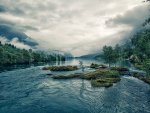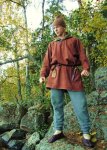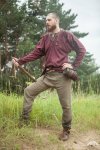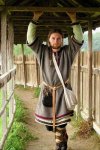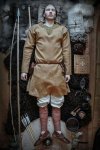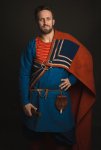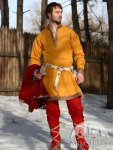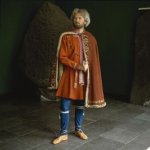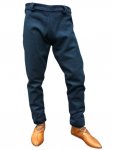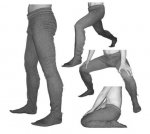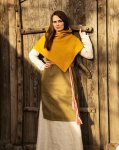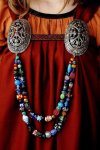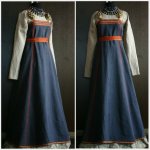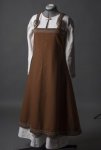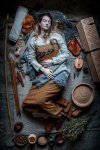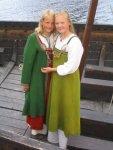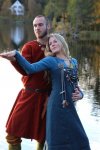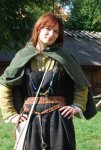You are using an out of date browser. It may not display this or other websites correctly.
You should upgrade or use an alternative browser.
You should upgrade or use an alternative browser.
D&D 5E Norse World
Yaarel
He Mage
For fun, I compiled a mythologically accurate world according to Norse texts.
It includes cosmological concepts, historical toponyms, and archeological assessments.
Five cosmological ‘realms’ appear on this map.
Niflheimr corresponds to the arctic cold. This ‘mist’ realm (niflr) is the Polar Ice Cap, floating on Hvergelmir, the frigid arctic ocean, with the arctic mist rising from it. The Norse seem unaware of the geography of Alaska and eastern Siberia, and evidently imagine even colder cold beyond. The eleven rivers of the Elivágar are possibly seasonal water courses on the ice cap, when the glacial ice thaws.
Múspellheimr corresponds to the equatorial heat. This ‘cataclysm’ realm is the Saharan Desert. Múspellr is of uncertain etymology but comes to mean an eschatological cataclysm, specifically a global conflagration of fire that occurs when the cosmos collapses during Ragnarǫk. The Norse seem unaware of the geography of Subsaharan Africa, and evidently imagine an even hotter heat beyond.
Jǫtunheimr is the mountain range that spans the length of Norway. The Jǫtnar are chaotic wilderness spirits, including stunningly beautiful ‘cliffrock giants’, Berg-Risar, as well as grotesque ‘frost ogres’, Hrím-Þursar. Jǫtnar who are spirits of such, can reach the size of a mountain, or even the land of a realm. But most Jǫtnar are humansize. Útgarðar are a group of locations in east Jǫtunheimr, featuring massive forests. This is probably Sweden that is almost entirely forested, especially the wildernesses of central Sweden whose forests are dense and seemingly endless. In addition to Scandinavia, Jǫtnar are said to populate the remote areas of what is today Finland.
Miðgarðr is land, the central realm of humans. Its defensive walls and ramparts of coastlands guard against the surrounding waters. It connotes continental Europe, with other landmasses being offshore. But later, Miðgarðr will come to be understood as encompassing the entire landmass of Africa-Eurasia, while the encircling cosmic ocean had made large watery invasions into it forming seas inside it.
Ásgarðr is the location where the orderly atmospheric spirits, the Æsir, hold their parliament. These nature spirits actually inhabit the ‘sky’ (Himinn) among the clouds. The sky is sometimes called the ‘realm of the Æsir’, Ásaheimr. But they descend daily onto land via a rainbow to hold their government meetings. There on earth, they vote to decide their activities. Snorri employs a folk etymology to identify the Æsir with ‘Asia’, thus identifies Ásgarðr with the ancient city of Troy. This links the sacred field, called Iðavǫllr (‘field of Íða’), where the outdoor parliament happens, with the prominent coastal mountain of Ida that looms over the city of Troy from the south.
Totaling nine cosmological realms, four are missing from the map.
Alfheimr. Where the realm of the Æsir is Ásaheimr among clouds in the atmosphere, the realm of the Alfar (elves) is in the stratosphere above them. Alfar are spirits of sunlight, embodying the rays of sunlight radiating around the sun, and downward as the gleaming lining of clouds, the sunbeams piercing thru clouds, thru tree branches, and reflecting off of brilliant snow. They embody positive fates of a success that impact many people. By extension, they associate with beauty, sexuality, and enchanting shamanic magic.
Vanaheimr is the ‘realm of the Vanir’. The Vanir are obscure. The only ones known by name, are the ones who became members of the Æsir. They appear to have much in common with the Alfar, sharing aspects of beauty, sexuality, fertility, success, and magic. Indeed, Alfheimr is said to be a gift to assist one of the Vanir. But where the Alfar associate more with sunlight, the Vanir associate more with the fertile breezes of lifegiving summer weather. On balance, Vanaheimr seems to be in today Sweden. King Sveigðir was at home in Svíþjóð when he married his wife Vana ‘in Vanaheimr’. Their son is Vanalandi ‘the man of the land of the Vanir’. Archeologically, the Vanir are indigenous to Scandinavia, and the highest concentrations of place names mentioning them are in Sweden. Vanaheimr associates with the relatively warm seabreezes across the shores of seas and lakes, as well as land that is fertile for farming.
Svartalfaheimr is the ‘realm of the black elves’, a nickname for the Dvergar. Dvergar are spirits of rocks and muck. They own great resources including precious metals, shapely minerals, and fertile soil, but they begrudge giving any of it way. It takes effort to obtain these resources from them. Dvergar embody negative fates of a futility that fails to impact others.
Below all is Hel, the realm of the dead. In some sense, Hel is any grave, and in an other an abstraction of all graves, existing deep underground. Altho Hel is below, the entrance of the tunnel winding downward toward Hel, is actually in arctic Niflheimr. So the spirits of the recently dying journey northward to the deathly ice, to the icecave that leads down into Hel. Hel itself is a realm of gloomly, listless, decay. Better afterlives can be found elsewhere if one dies bravely.
During the Viking Era, Norse exploration and trade spans the hemisphere of planet earth. The toponyms of faraway locations appear in Norse texts.
In the center, Noregr roughly corresponds to today Norway. A ‘Norse World’ would benefit from a closeup map for the prominent localities in Norway such as Rogaland, Raumariki, Alfheimr, and so on. Many viking expeditions launch from Þrǿndalǫg. Hálogaland corresponds roughly to the northern half of today Norway. Its founding monarch is said to be a Jǫtunn, specifically a Risar named Logi, ‘fire’, who is the spirit of fire. He was also knicknamed Hálogi, ‘high fire’, ‘high’ because of his height and muscularity. He and his aristocratic lineage are famous for their extreme beauty.
The Norse from Noregr established towns and trading posts in Ísland (Iceland) and Grœnland (Greenland), and even in North America. Canadian archeologists have established that the Norse maintained traderoutes with Native Americans, including Inuit and probably Dorset. As such, the archeologists identify the Norse placename Helluland with the arctic Baffin Isles and Markland with Labrador. Both are across from the westcoast of Grœnland.
Archeologists associate Vínland with the famous viking town that was discovered in today Newfoundland, Canada. The Norse continued to explore the coastlands and riverbanks of North America. This name suggests that this ‘land of wine’ extends at least as far south as Massachusetts, US, where grapes grow. Toward Massachusetts, a runic inscription has been discovered in Nova Scotia, Canada, and a Norse coin discovered in Maine, US.
Skotland, Írland, and Bretland, are Celtic regions of the British Isles. The Norse from Noregr establish a number of towns among them, including Dyflin (Dublin), Suðreyjar (Hebrides), and elsewhere.
Svíðjóþ roughly corresponds to today Sweden. It comprises both the northern Svealand with its city of Uppsala and the southern Gautland. The Norse understood the southerly Gautar ethnic group to be the origins of all Gothic peoples across Europe. A cautious archeological assessment of this claim is, the Goths are a group of diverse ethnicities, and the ethnicity in Gautland appears to be one of them.
Note ‘Greater Svíðjóþ’ extends to include all of the Norse towns and trading posts that were established along the river routes thru today Finland, Russia, Belarus, and the Ukraine, that link Sweden to the Black Sea and the Caspian Sea.
Norse towns along the river routes include Holmgarðr (today Novgorod) being the capital city of a number of Norse towns that comprise the wider region known as Garðariki (‘the government of the towns’). Further south along a river route is Kœnugarðr (today Kiev). Later, a ruler of Garðariki relocates the capital south to Kœnugarðr. Eventually integrating the various Slav ethnic groups, the region develops into the Kievan Rus', from where today Russia, Belarus, and Ukraine descend culturally.
Finnland is the land of the Finnar. The name Finnr literally means ‘finder’ (of food) referring to the nomadic hunter-gatherers. For those in Noregr the Finnar are understood to be Sámi across the arctic Scandinavia. For those in Svíðjóþ the Finnar are understood to be the related but distinct Saomo across today Finland. The spiritual leaders of the Finnar are shamans, called a Noaidi. Likewise, the only spiritual leaders of the Norse are shamans. But Norse shamans can only be females, formally called a Vǫlva. By extension, a Norse male who demonstrates shamanic power comes to be honored informally as a ‘Finnr’ (sometimes ‘Fiðr’), referring to the Finn Noaidi who can be male.
Danmǫrk corresponds roughly to today Denmark. It is mainly northerly Jótland (Jutland) but its rule extends Danlǫg (Dane Law) to England. Most of the time, Skáney (today Skåne, the southmost tip of Sweden) was under the rule of Danmǫrk.
Skáney, where -ey means ‘island’ or coastland, derives from Proto-Norse *Skaþin-awjō, known to ancient Romans as Latin ‘Scadinavia’. This term and its later variant ‘Scandinavia’ referred to Skáney only. But in the Modern Period, it extended to mean the entire peninsula of Norway-Sweden, along with Denmark. English sometimes refers to Skáney as Scania.
Jórsalir is the Norse name for Yerushalayim. It can refer to the entire land of Yisrael, sometimes called Jórsala Land, and it can refer to the city, sometimes called the ‘walled-town of Yerushalayim’, Jórsalaborg. Later, Yerushalayim comes to be understood as the center of the landmass comprising all of Africa-Eurasia.
The traderoutes of Svíðjóþ that connect the Norse to the Black Sea and Caspian Sea, thereby join the economies of the empires of Miklagarðr (Konstantinopolis), Serkland (Arab Bagdad), Sarkland (the Khazars), Persiðialand (today Iran), and join up with the Silk Route that connects to China. The Norse call the Byzantine Empire of Konstantinopolos Grikkland, ‘Greek land’. Originally Serkland refers to the northern tribes of Arabia, collectively referred to as Serkar, but by extension comes to mean all of Arabia and the entire Arab world. So the Norse sometimes refer northern coastal areas of Africa as Serkland. The name Afrikka mainly corresponds to today Tunis. When Norse refer to the continent of Africa, they use the term Bláland, which is properly Ethiopia, but extends to include dark skin Africans. The kingdom of the Khazars is called Sarkland, deriving the name from Sarkel (Sarkel-land), which is a prominent Khazar fortress near the river route. Around the Caspian Sea, Tyrkland corresponds mainly to today Turkmanistan, but is already expanding across the southwest side of the Caspian Sea. Thru the traderoutes, the Norse are aware of India and Bactria (a Hellenistic polis instituted by Alexandros the Great at Bakhlo, north of Afghanistan). Merchants from these places also travel these traderoutes, and perhaps Norse individuals have even ventured there. Egiptaland (Egypt) is a vibrant traderoute connecting the Mediterranean to the seafaring routes of Persiðia and India.
Saxland corresponds roughly to today northern Germany. Frakkland corresponds roughly to today France, and relates to the Holy Roman Empire under Charlemagne the Frank. Before the Viking Period, Frakkland of the Roman Empire under the Merovingians is sometimes known as Hunnland, apparently relating to the Huganot family. Langbarðaland relates to today Lombardy, but earlier ruled over most of Italy and corresponds to today Italy. Ungarariki corresponds roughly to today Hungary.
(Image. Without text, the base image of the planet comes from globalquiz.org/en/norway-quiz. It has good image resolution for a cloudless earth from this northerly perspective. The bullseye focuses on the city of Oslo, Norway. I modified the original image for esthetics and emphasis, added Norse toponyms.)
It includes cosmological concepts, historical toponyms, and archeological assessments.
Five cosmological ‘realms’ appear on this map.
Niflheimr corresponds to the arctic cold. This ‘mist’ realm (niflr) is the Polar Ice Cap, floating on Hvergelmir, the frigid arctic ocean, with the arctic mist rising from it. The Norse seem unaware of the geography of Alaska and eastern Siberia, and evidently imagine even colder cold beyond. The eleven rivers of the Elivágar are possibly seasonal water courses on the ice cap, when the glacial ice thaws.
Múspellheimr corresponds to the equatorial heat. This ‘cataclysm’ realm is the Saharan Desert. Múspellr is of uncertain etymology but comes to mean an eschatological cataclysm, specifically a global conflagration of fire that occurs when the cosmos collapses during Ragnarǫk. The Norse seem unaware of the geography of Subsaharan Africa, and evidently imagine an even hotter heat beyond.
Jǫtunheimr is the mountain range that spans the length of Norway. The Jǫtnar are chaotic wilderness spirits, including stunningly beautiful ‘cliffrock giants’, Berg-Risar, as well as grotesque ‘frost ogres’, Hrím-Þursar. Jǫtnar who are spirits of such, can reach the size of a mountain, or even the land of a realm. But most Jǫtnar are humansize. Útgarðar are a group of locations in east Jǫtunheimr, featuring massive forests. This is probably Sweden that is almost entirely forested, especially the wildernesses of central Sweden whose forests are dense and seemingly endless. In addition to Scandinavia, Jǫtnar are said to populate the remote areas of what is today Finland.
Miðgarðr is land, the central realm of humans. Its defensive walls and ramparts of coastlands guard against the surrounding waters. It connotes continental Europe, with other landmasses being offshore. But later, Miðgarðr will come to be understood as encompassing the entire landmass of Africa-Eurasia, while the encircling cosmic ocean had made large watery invasions into it forming seas inside it.
Ásgarðr is the location where the orderly atmospheric spirits, the Æsir, hold their parliament. These nature spirits actually inhabit the ‘sky’ (Himinn) among the clouds. The sky is sometimes called the ‘realm of the Æsir’, Ásaheimr. But they descend daily onto land via a rainbow to hold their government meetings. There on earth, they vote to decide their activities. Snorri employs a folk etymology to identify the Æsir with ‘Asia’, thus identifies Ásgarðr with the ancient city of Troy. This links the sacred field, called Iðavǫllr (‘field of Íða’), where the outdoor parliament happens, with the prominent coastal mountain of Ida that looms over the city of Troy from the south.
Totaling nine cosmological realms, four are missing from the map.
Alfheimr. Where the realm of the Æsir is Ásaheimr among clouds in the atmosphere, the realm of the Alfar (elves) is in the stratosphere above them. Alfar are spirits of sunlight, embodying the rays of sunlight radiating around the sun, and downward as the gleaming lining of clouds, the sunbeams piercing thru clouds, thru tree branches, and reflecting off of brilliant snow. They embody positive fates of a success that impact many people. By extension, they associate with beauty, sexuality, and enchanting shamanic magic.
Vanaheimr is the ‘realm of the Vanir’. The Vanir are obscure. The only ones known by name, are the ones who became members of the Æsir. They appear to have much in common with the Alfar, sharing aspects of beauty, sexuality, fertility, success, and magic. Indeed, Alfheimr is said to be a gift to assist one of the Vanir. But where the Alfar associate more with sunlight, the Vanir associate more with the fertile breezes of lifegiving summer weather. On balance, Vanaheimr seems to be in today Sweden. King Sveigðir was at home in Svíþjóð when he married his wife Vana ‘in Vanaheimr’. Their son is Vanalandi ‘the man of the land of the Vanir’. Archeologically, the Vanir are indigenous to Scandinavia, and the highest concentrations of place names mentioning them are in Sweden. Vanaheimr associates with the relatively warm seabreezes across the shores of seas and lakes, as well as land that is fertile for farming.
Svartalfaheimr is the ‘realm of the black elves’, a nickname for the Dvergar. Dvergar are spirits of rocks and muck. They own great resources including precious metals, shapely minerals, and fertile soil, but they begrudge giving any of it way. It takes effort to obtain these resources from them. Dvergar embody negative fates of a futility that fails to impact others.
Below all is Hel, the realm of the dead. In some sense, Hel is any grave, and in an other an abstraction of all graves, existing deep underground. Altho Hel is below, the entrance of the tunnel winding downward toward Hel, is actually in arctic Niflheimr. So the spirits of the recently dying journey northward to the deathly ice, to the icecave that leads down into Hel. Hel itself is a realm of gloomly, listless, decay. Better afterlives can be found elsewhere if one dies bravely.
During the Viking Era, Norse exploration and trade spans the hemisphere of planet earth. The toponyms of faraway locations appear in Norse texts.
In the center, Noregr roughly corresponds to today Norway. A ‘Norse World’ would benefit from a closeup map for the prominent localities in Norway such as Rogaland, Raumariki, Alfheimr, and so on. Many viking expeditions launch from Þrǿndalǫg. Hálogaland corresponds roughly to the northern half of today Norway. Its founding monarch is said to be a Jǫtunn, specifically a Risar named Logi, ‘fire’, who is the spirit of fire. He was also knicknamed Hálogi, ‘high fire’, ‘high’ because of his height and muscularity. He and his aristocratic lineage are famous for their extreme beauty.
The Norse from Noregr established towns and trading posts in Ísland (Iceland) and Grœnland (Greenland), and even in North America. Canadian archeologists have established that the Norse maintained traderoutes with Native Americans, including Inuit and probably Dorset. As such, the archeologists identify the Norse placename Helluland with the arctic Baffin Isles and Markland with Labrador. Both are across from the westcoast of Grœnland.
Archeologists associate Vínland with the famous viking town that was discovered in today Newfoundland, Canada. The Norse continued to explore the coastlands and riverbanks of North America. This name suggests that this ‘land of wine’ extends at least as far south as Massachusetts, US, where grapes grow. Toward Massachusetts, a runic inscription has been discovered in Nova Scotia, Canada, and a Norse coin discovered in Maine, US.
Skotland, Írland, and Bretland, are Celtic regions of the British Isles. The Norse from Noregr establish a number of towns among them, including Dyflin (Dublin), Suðreyjar (Hebrides), and elsewhere.
Svíðjóþ roughly corresponds to today Sweden. It comprises both the northern Svealand with its city of Uppsala and the southern Gautland. The Norse understood the southerly Gautar ethnic group to be the origins of all Gothic peoples across Europe. A cautious archeological assessment of this claim is, the Goths are a group of diverse ethnicities, and the ethnicity in Gautland appears to be one of them.
Note ‘Greater Svíðjóþ’ extends to include all of the Norse towns and trading posts that were established along the river routes thru today Finland, Russia, Belarus, and the Ukraine, that link Sweden to the Black Sea and the Caspian Sea.
Norse towns along the river routes include Holmgarðr (today Novgorod) being the capital city of a number of Norse towns that comprise the wider region known as Garðariki (‘the government of the towns’). Further south along a river route is Kœnugarðr (today Kiev). Later, a ruler of Garðariki relocates the capital south to Kœnugarðr. Eventually integrating the various Slav ethnic groups, the region develops into the Kievan Rus', from where today Russia, Belarus, and Ukraine descend culturally.
Finnland is the land of the Finnar. The name Finnr literally means ‘finder’ (of food) referring to the nomadic hunter-gatherers. For those in Noregr the Finnar are understood to be Sámi across the arctic Scandinavia. For those in Svíðjóþ the Finnar are understood to be the related but distinct Saomo across today Finland. The spiritual leaders of the Finnar are shamans, called a Noaidi. Likewise, the only spiritual leaders of the Norse are shamans. But Norse shamans can only be females, formally called a Vǫlva. By extension, a Norse male who demonstrates shamanic power comes to be honored informally as a ‘Finnr’ (sometimes ‘Fiðr’), referring to the Finn Noaidi who can be male.
Danmǫrk corresponds roughly to today Denmark. It is mainly northerly Jótland (Jutland) but its rule extends Danlǫg (Dane Law) to England. Most of the time, Skáney (today Skåne, the southmost tip of Sweden) was under the rule of Danmǫrk.
Skáney, where -ey means ‘island’ or coastland, derives from Proto-Norse *Skaþin-awjō, known to ancient Romans as Latin ‘Scadinavia’. This term and its later variant ‘Scandinavia’ referred to Skáney only. But in the Modern Period, it extended to mean the entire peninsula of Norway-Sweden, along with Denmark. English sometimes refers to Skáney as Scania.
Jórsalir is the Norse name for Yerushalayim. It can refer to the entire land of Yisrael, sometimes called Jórsala Land, and it can refer to the city, sometimes called the ‘walled-town of Yerushalayim’, Jórsalaborg. Later, Yerushalayim comes to be understood as the center of the landmass comprising all of Africa-Eurasia.
The traderoutes of Svíðjóþ that connect the Norse to the Black Sea and Caspian Sea, thereby join the economies of the empires of Miklagarðr (Konstantinopolis), Serkland (Arab Bagdad), Sarkland (the Khazars), Persiðialand (today Iran), and join up with the Silk Route that connects to China. The Norse call the Byzantine Empire of Konstantinopolos Grikkland, ‘Greek land’. Originally Serkland refers to the northern tribes of Arabia, collectively referred to as Serkar, but by extension comes to mean all of Arabia and the entire Arab world. So the Norse sometimes refer northern coastal areas of Africa as Serkland. The name Afrikka mainly corresponds to today Tunis. When Norse refer to the continent of Africa, they use the term Bláland, which is properly Ethiopia, but extends to include dark skin Africans. The kingdom of the Khazars is called Sarkland, deriving the name from Sarkel (Sarkel-land), which is a prominent Khazar fortress near the river route. Around the Caspian Sea, Tyrkland corresponds mainly to today Turkmanistan, but is already expanding across the southwest side of the Caspian Sea. Thru the traderoutes, the Norse are aware of India and Bactria (a Hellenistic polis instituted by Alexandros the Great at Bakhlo, north of Afghanistan). Merchants from these places also travel these traderoutes, and perhaps Norse individuals have even ventured there. Egiptaland (Egypt) is a vibrant traderoute connecting the Mediterranean to the seafaring routes of Persiðia and India.
Saxland corresponds roughly to today northern Germany. Frakkland corresponds roughly to today France, and relates to the Holy Roman Empire under Charlemagne the Frank. Before the Viking Period, Frakkland of the Roman Empire under the Merovingians is sometimes known as Hunnland, apparently relating to the Huganot family. Langbarðaland relates to today Lombardy, but earlier ruled over most of Italy and corresponds to today Italy. Ungarariki corresponds roughly to today Hungary.
(Image. Without text, the base image of the planet comes from globalquiz.org/en/norway-quiz. It has good image resolution for a cloudless earth from this northerly perspective. The bullseye focuses on the city of Oslo, Norway. I modified the original image for esthetics and emphasis, added Norse toponyms.)
Last edited:
andreaslundin
Villager
Note that the south of the Scandinavian peninsula (today Skåne in Sweden) should probably be a Mark of Danland...
Yaarel
He Mage
The Norse venerate nature. Place names evidence the sacred worldview.
All land is sacred. In Noregr, the outdoor sacred spaces generally organize according to the sacred ways of life:
• hunting wilderness
• fishing coast
• farming meadow
• meditating cliff
Except for hosting a feast in ones home, all sacred activities occur outdoors communing with nature.
Sacred land locations that relate to the hunting wilderness are often an only source of food in winter:
• dalr ‘valley’, with a reliable frequency of animals to hunt
• þveit ‘clearing’, a treeless area in a forest with flourishing plant life.
Sacred land locations that relate to the fishing coast, include:
• vík ‘inlet’, small bay, often river estuary; whence víkingr, traveling from inlet to inlet
• ey ‘island’ − an island with a notable sacred feature is sacred to sailors
Sacred land locations that relate to the farming meadow, include:
• akr ‘grain field’
• vin ‘pasture’, grazing land for herding sheep, goats, and cattle; not to be confused with vín wine or vinr friend.
• setr ‘dairy pasture’, specifically for cows for milk
Sacred land locations that relate to the meditating cliff, include:
• nes ‘headland’, land that juts out over a sea or lake, with vertical sides
• berg ‘cliffrock’, rockface, vertical expanse of exposed bedrock, such as vertical cliff of mountain or vertical surface of large boulder
A scenic cliff that soars upward from the ground or water typically invites contemplation of the sky as a living being. Certain cliffs might relate to an other feature nearby, such as a grain field or a valley, with a view to inspire other contemplation.
On top of a cliff one can commune with the lives of the features of the sky, the Æsir. At the foot of a cliff, one can commune with the lives of the features of the rockface of the cliff, the Risar.
Nature is sacred. Prominent, conspicuous, dramatic landscapes invite awareness of this natural holiness.
In the animistic worldview, each natural phenomenon is conscious. At a sacred location, the Norse strive to be friends with the psychic presence of the natural phenomenon. The ethic seeks mutual respect and assistance. A site that makes a strong impression can manifest in dreams, visions, or even physically, taking on the form of a human. Compare how some humans are said to be able to project outofbody, to interact with an other mind, even to manifest physically elsewhere, sometimes taking on an alternate form. The minds of some meaningful stones or terrains or atmospheric phenomena can do likewise. A friendly presence can imbue beneficial influence.
The recognition of a sacred natural site can be a source of pride for nearby homes. Often anecdotes recall a wondrous occurrence that happened at the site. Or an eerie one.
A person can place a vé ‘sacred boundary marker’ around or adjacent to an outdoor sacred site, often a fence of loose stones, or of a cord on wood posts. It separates a special sacred space from nearby mundane activities, or calls attention to a sacred space at a remote location. Any violence within a vé is extremely forbidden. The þing ‘democratic parliament’ is an aboriginal sacred custom. Its regional governmental sessions take place outdoors on a field within a vé, often juxtaposing an other sacred natural feature.
A person might have a hof shrine in ones home on a farm. Sometimes a bowl is there to share some of a feast. Originally, the term meant farm, extended to mean the sacredness of the family, the home, the success of the farm, and the land that the farm is on. The hof is personal and can honor any phenomenon that one or ones family feels a friendship with. Typically, an annual feast invites the presence of this natural phenomenon as a guest. (Something like an anniversary party today.) Some hosts invite friends and neighbors to come celebrate as well.
Animism values hospitality as a sacred ideal. One is to live in harmony with the surrounding features of nature, making friends with helpful features and being savvy with dangerous features.
Humans too are a feature of nature, are a family of vættir ‘nature spirits’, and likewise seek neighborly relationships with other families of vættir nature spirits.
All land is sacred. In Noregr, the outdoor sacred spaces generally organize according to the sacred ways of life:
• hunting wilderness
• fishing coast
• farming meadow
• meditating cliff
Except for hosting a feast in ones home, all sacred activities occur outdoors communing with nature.
Sacred land locations that relate to the hunting wilderness are often an only source of food in winter:
• dalr ‘valley’, with a reliable frequency of animals to hunt
• þveit ‘clearing’, a treeless area in a forest with flourishing plant life.
Sacred land locations that relate to the fishing coast, include:
• vík ‘inlet’, small bay, often river estuary; whence víkingr, traveling from inlet to inlet
• ey ‘island’ − an island with a notable sacred feature is sacred to sailors
Sacred land locations that relate to the farming meadow, include:
• akr ‘grain field’
• vin ‘pasture’, grazing land for herding sheep, goats, and cattle; not to be confused with vín wine or vinr friend.
• setr ‘dairy pasture’, specifically for cows for milk
Sacred land locations that relate to the meditating cliff, include:
• nes ‘headland’, land that juts out over a sea or lake, with vertical sides
• berg ‘cliffrock’, rockface, vertical expanse of exposed bedrock, such as vertical cliff of mountain or vertical surface of large boulder
A scenic cliff that soars upward from the ground or water typically invites contemplation of the sky as a living being. Certain cliffs might relate to an other feature nearby, such as a grain field or a valley, with a view to inspire other contemplation.
On top of a cliff one can commune with the lives of the features of the sky, the Æsir. At the foot of a cliff, one can commune with the lives of the features of the rockface of the cliff, the Risar.
Nature is sacred. Prominent, conspicuous, dramatic landscapes invite awareness of this natural holiness.
In the animistic worldview, each natural phenomenon is conscious. At a sacred location, the Norse strive to be friends with the psychic presence of the natural phenomenon. The ethic seeks mutual respect and assistance. A site that makes a strong impression can manifest in dreams, visions, or even physically, taking on the form of a human. Compare how some humans are said to be able to project outofbody, to interact with an other mind, even to manifest physically elsewhere, sometimes taking on an alternate form. The minds of some meaningful stones or terrains or atmospheric phenomena can do likewise. A friendly presence can imbue beneficial influence.
The recognition of a sacred natural site can be a source of pride for nearby homes. Often anecdotes recall a wondrous occurrence that happened at the site. Or an eerie one.
A person can place a vé ‘sacred boundary marker’ around or adjacent to an outdoor sacred site, often a fence of loose stones, or of a cord on wood posts. It separates a special sacred space from nearby mundane activities, or calls attention to a sacred space at a remote location. Any violence within a vé is extremely forbidden. The þing ‘democratic parliament’ is an aboriginal sacred custom. Its regional governmental sessions take place outdoors on a field within a vé, often juxtaposing an other sacred natural feature.
A person might have a hof shrine in ones home on a farm. Sometimes a bowl is there to share some of a feast. Originally, the term meant farm, extended to mean the sacredness of the family, the home, the success of the farm, and the land that the farm is on. The hof is personal and can honor any phenomenon that one or ones family feels a friendship with. Typically, an annual feast invites the presence of this natural phenomenon as a guest. (Something like an anniversary party today.) Some hosts invite friends and neighbors to come celebrate as well.
Animism values hospitality as a sacred ideal. One is to live in harmony with the surrounding features of nature, making friends with helpful features and being savvy with dangerous features.
Humans too are a feature of nature, are a family of vættir ‘nature spirits’, and likewise seek neighborly relationships with other families of vættir nature spirits.
Last edited:
Yaarel
He Mage
The Norse perceive all meaningful natural phenomena as conscious beings who can interact with each other.
The places for good hunting are a lifeforce called Ullr, who can engage in a dreamlike way to manifest as a hunter, mastering archery and personal combat, snowshoeing across the winter ice and snow.
The Norse experience fertile coasts with reliable fishing spots as a dreamlike persona of Njǫrðr, a sailor of warm breezes. (Despite the northern latitude of Noregr, the Gulf Stream from the Caribbean Sea keeps the Norwegian coasts relatively warm. Sometimes coconuts drift onto the shores of Norway.)
The Norse experience the psychic presence of meadows that are suitable for farming and grazing as the consciousness of Freyr, a sexy, peaceful, and successful farmer.
The vertical cliffs that Noregr is famous for invite contemplation of the sky and of the cosmic horizon all around. Where we say ‘meditate’, the Norse say ‘sit’, or sometimes ‘sit out’, to commune with nature spirits. Compare the Finnar (Sámi) sacred tradition of ‘joik’, employing spontaneous and traditional chanting melodies to become one with any nature spirit − including honoring the presence of an other human. The Norse shamanic traditions share similar customs. There on the heights of the sheer surface of a cliff, there is awe of the holiness of nature. A wider perspective. A sense of cosmic order. For the Norse, lightning associates this mental experience. For the Norse, lightning is conscious and can engage in a dreamlike way as the persona of Þórr − an electric and thundering warrior who rides the sky in a rumbling chariot to protect humans in Noregr against deadly forces of chaos. The lightning flash of his weapon and its thunderous impact against the wilds also enforce the sacred oaths among the Norse. The natural phenomena of lightning and thunder is a conscious living creature − purposeful and protective.
The skyscape of a cliff might invite the contemplation of other celestial phenomena as well. For example, Baldr the consciousness of the daylight sky makes a rare appearance at certain sacred coastal cliffs where daylight reflects in the waters.
Even so, four nature spirits, Ullr, Njǫrðr, Freyr, and Þórr, appear most frequently in the names of Noregr sacred landscapes. Þórr especially.
Note, while these nature spirits tend to associate with respective categories of landscapes, all four are members of the Æsir family of nature spirits. They are atmospheric phenomena. Njǫrðr is the consciousness of seabreezes. Freyr is the consciousness of gentle rains accompanying the warm sunbeams of the Alfar. Þórr is actual thunder and lightning across the sky. Inferably Ullr is the calm that is conducive to hunters and archers and that brings comfort in winter chill.
Heh, it somewhat reminds me of Magic The Gathering − how certain ‘lands’ correspond to certain ‘colors’.
The respective landscapes invite the holistic influences of certain atmospheric phenomena. Etymologically, the name ‘Æsir’ derives from Proto-Norse *AnsuR becoming Áss in Old Norse, plural Æsir. (This name is not to be confused with the Norse homonym áss meaning a ‘ridge’, the line where two rocky slopes incline upward to meet, deriving from *AnsaR.) Æsir literally means ‘spirits’, in both senses of ‘consciousnesses’ and ‘winds’. In Old Norse, the name comes to specify the Æsir wind spirits. The Norse credit atmospheric winds with shaping and ordering the world.
Norwegian archeologists have shown that the first city in Norway was founded in year 997 toward the end of the Viking Period, Þróndheimr. The first city ever. It is difficult for us moderns to wrap our head around it. The Norse perception of the holy is fundamentally nonurban.
In the Norse reality, the sacred is aboriginal, remote, and shamanist. The various objects of nature ‘who’ surround them, are alive. The Norse honor these multivarious facets of nature in the same ways that the Norse honor each other.
The places for good hunting are a lifeforce called Ullr, who can engage in a dreamlike way to manifest as a hunter, mastering archery and personal combat, snowshoeing across the winter ice and snow.
The Norse experience fertile coasts with reliable fishing spots as a dreamlike persona of Njǫrðr, a sailor of warm breezes. (Despite the northern latitude of Noregr, the Gulf Stream from the Caribbean Sea keeps the Norwegian coasts relatively warm. Sometimes coconuts drift onto the shores of Norway.)
The Norse experience the psychic presence of meadows that are suitable for farming and grazing as the consciousness of Freyr, a sexy, peaceful, and successful farmer.
The vertical cliffs that Noregr is famous for invite contemplation of the sky and of the cosmic horizon all around. Where we say ‘meditate’, the Norse say ‘sit’, or sometimes ‘sit out’, to commune with nature spirits. Compare the Finnar (Sámi) sacred tradition of ‘joik’, employing spontaneous and traditional chanting melodies to become one with any nature spirit − including honoring the presence of an other human. The Norse shamanic traditions share similar customs. There on the heights of the sheer surface of a cliff, there is awe of the holiness of nature. A wider perspective. A sense of cosmic order. For the Norse, lightning associates this mental experience. For the Norse, lightning is conscious and can engage in a dreamlike way as the persona of Þórr − an electric and thundering warrior who rides the sky in a rumbling chariot to protect humans in Noregr against deadly forces of chaos. The lightning flash of his weapon and its thunderous impact against the wilds also enforce the sacred oaths among the Norse. The natural phenomena of lightning and thunder is a conscious living creature − purposeful and protective.
The skyscape of a cliff might invite the contemplation of other celestial phenomena as well. For example, Baldr the consciousness of the daylight sky makes a rare appearance at certain sacred coastal cliffs where daylight reflects in the waters.
Even so, four nature spirits, Ullr, Njǫrðr, Freyr, and Þórr, appear most frequently in the names of Noregr sacred landscapes. Þórr especially.
Note, while these nature spirits tend to associate with respective categories of landscapes, all four are members of the Æsir family of nature spirits. They are atmospheric phenomena. Njǫrðr is the consciousness of seabreezes. Freyr is the consciousness of gentle rains accompanying the warm sunbeams of the Alfar. Þórr is actual thunder and lightning across the sky. Inferably Ullr is the calm that is conducive to hunters and archers and that brings comfort in winter chill.
Heh, it somewhat reminds me of Magic The Gathering − how certain ‘lands’ correspond to certain ‘colors’.
The respective landscapes invite the holistic influences of certain atmospheric phenomena. Etymologically, the name ‘Æsir’ derives from Proto-Norse *AnsuR becoming Áss in Old Norse, plural Æsir. (This name is not to be confused with the Norse homonym áss meaning a ‘ridge’, the line where two rocky slopes incline upward to meet, deriving from *AnsaR.) Æsir literally means ‘spirits’, in both senses of ‘consciousnesses’ and ‘winds’. In Old Norse, the name comes to specify the Æsir wind spirits. The Norse credit atmospheric winds with shaping and ordering the world.
Norwegian archeologists have shown that the first city in Norway was founded in year 997 toward the end of the Viking Period, Þróndheimr. The first city ever. It is difficult for us moderns to wrap our head around it. The Norse perception of the holy is fundamentally nonurban.
In the Norse reality, the sacred is aboriginal, remote, and shamanist. The various objects of nature ‘who’ surround them, are alive. The Norse honor these multivarious facets of nature in the same ways that the Norse honor each other.
Last edited:
Yaarel
He Mage
Here is a good presentation of the rúnar (runes) that are in use among the Norse during the Viking Period.
In Noregr, there are 15 rúna-stafir (runes letters) in the Norse alphabet fuþórk. In other parts of Scandinavia, there are still 16. But in the (Old West Norse) Noregr dialect the r-sound and the R-sound merged into the same r-sound. So the sixteenth rúnastafr for the obsolete R-sound fell out of use. The r-rúnastafr extended to displace it. The lost Proto-Norse R-sound reconstructs as a retroflexive [ɽ]. (This is sort of like the American r, but more fricative against the palate.) The exact sound of the r that prevails in Old Norse remains debatable. Linguists reconstruct it variously, possibly a tap [ɾ] or a uvular [ʁ], or a trill [r]. Today in the modern Scandinavian languages all three r sounds survive in various dialects, and there are regional dialects of Old Norse during the Viking Period too, plausibly with different r sounds.
Notice, these 15 ‘viking runes’ differ from the 24 runes that today pop culture might be familiar with. In fact, these 24 ‘elder runes’ did exist in Scandinavia for Proto-Norse during the 200s to 400s. But by the time of Old Norse during the Viking Period, these elder runes had been out of use for centuries. During the 500s to 700s, many experimental variants are extent. By the 800s, at the start of the Viking Period, they somewhat stabilize. The nickname ‘younger runes’ corresponds to the Old Norse rúnar that the víkingar use.
In the 900s, the vowel letters for Old Norse rúnar were as follows. The ã-rúnastafr can represent any nasalized vowel sound. In some places where Proto-Norse had a vowel followed by [n], by the time of Old Norse, the vowel assimilated it becoming a nasalized vowel. (Compare today French which similarly features many nasalized vowels.) The u-rúnastafr can represent any rounded vowel [u, o, ǫ, ø, y]. The i-rúnastafr can represent any frontal vowel [i, y, ø, e]. And the a-rúnastafr can represent any open vowel [a, ǫ, ø, ę, æ]. So, rúnar inscriptions evidence many spelling variations.
By the 1000s, the nasalized vowels ceased to exist in the Noregr dialect. So the Noregr runic tradition repurposed the obsolete ã-rúnastafr to now serve as a rúnastafr for the vowel [o], thus innovating the o-rúnastafr , whence the alphabet name, ‘fuþórk’.
As an other innovation some decades later, some Noregr rúna-meistari (runes master) repurposed the long-gone R-rúnastafr , called Yr (‘yew’ tree), to now represent the rounded frontal vowel [y]. From this point on, the runic vowel letters came to narrow the possible vowel sounds. Around the same time, a pointed i-rúnastafr added to the fuþórk to distinguish the vowel [e] from other frontal vowels relating to the i-rúnastafr. The shape of this new e-rúnastafr resembles an obsolete short-twig script h-rúnastafr, so in some sense both earlier rúnastafir R and h found reuse as vowel letters. The use of vowel letters, o, y, and e spread across Scandinavia, making u and i more precise as well.
Across the Viking Period, the consonant letters can represent both the voiced and unvoiced sounds. For example, the k-rúnastafr can represent both unvoiced [k] and voiced [g], as well as nasal ‘ng’ [ŋ]. Note, a soft velar fricative [ᵞ] can be either the k-rúnstafr or the i-rúnstafr, or sometimes silent.
During the Post-Viking Period, 1100s to 1300s, increasing exposure to Pan-European literature and its Latin alphabet, inspired runic traditions to innovate more rúnastafir by adding modifications of related ones, so as to distinguish between voiced and unvoiced, and so on, thus forming a highly precise phonetic alphabet that remained in use as the ordinary alphabet in Noregr thruout this period.
During the Viking Period (800s to 1000s), several rúnar scripts are in use simultaneously. The script that tends to prevail in Svíþjórð is the ‘short twig’ script, the one that tends to prevail in Danmǫrk is the ‘long branch’ script, and the one that tends to prevail in Noregr (illustrated above and below) is a distinctive script that shares certain features with both of them. Much less frequently, certain other scripts are in use across Scandinavia.
The names of the rúnastafir (runes letters) are.
ᚠ Fé ‘asset’ (money or cattle)
ᚢ Úr ‘dross’ (from iron ore)
ᚦ Þurs ‘ogre’ (grotesque frost Jǫtunn)
ᚮ Óss ‘estuary’ (especially as sailing port) (obsolete Áss ‘sky spirit’)
ᚱ Reið ‘ride’ (such as on horse or wagon, or further developing work done by others)
ᚴ Kaun ‘ulcer’ (such as infected skin boil)
ᚼ Hagall ‘hail’ (understood as a seed of matter and the material world)
ᚿ Nauð ‘need’ (painful, but motivating innovation, and sometimes connoting a wish)
ᛁ Íss ‘ice’ (able to bridge over deadly waters, yet can be deadly itself)
ᛆ Ár ‘year’ (but in the sense of annual harvest and abundance)
ᛌ Sól ‘sun’ (a gentle lifegiving warmth)
ᛐ Týr ‘victory’ (an obscure sky spirit but connoting singlemindedness in struggle culminating success)
ᛒ Bjarkan ‘birch’ tree (apparently connoting deception − unsure why)
ᛘ Maðr ‘human’ (the Mennir family of vættir nature spirits, connoting farming, sailing, hunting)
ᛚ Lǫgr ‘mountain lake’ (receiving and giving freshwater rivers, especially above a waterfall)
The rúnastafr ᛦ Yr ‘yew’ (connoting a longbow made out of yew wood), discontinues as R around the start of the Viking Period but revives as y around the end of the Viking Period.
The Norse can employ runic inscriptions for magical purposes. Many examples survive in the archeological record. No two inscriptions are alike. Norse magic is individualist, spontaneous, and diverse. It is more important to be in the moment, to emanate personal influence.
Norse magic is mainly verbal, but can be silent, or even unintentional. A warrior can improvise a new ‘chant’ (ljóð) as a focus to manifest protective magic (defense, healing, warding, restoration, abjuration). There are occasional examples of employing a somatic ritual, apparently drumming a vǫlr shamanic staff on the ground for a psychic attack against a distant mind, sitting on an elevated ‘high’ seat to enhance clairsentient ‘sight’, and one woman cursing while bending over to see the target upside down thru her legs. Evidently, Norse men tend to sing protective magic musically, while women modeling the female Vǫlva shaman tend to speak mind-manipulating magic in prose. Notable examples exist that are probably fair to characterize as crossgender magic. Yet its wielders can still exemplify a cisgender identity. For example, there are masculine men who demonstrate feminine mind-manipulating seiðr, and feminine women who demonstrate masculine galdra chanting. Anecdotes about the Alfar (where Alfar are men and Valkyrjur are inferably Alfar women) show both sexes mastering every form of magic, both protective and mind-manipulating. Moreover, anyone who can prophesy (spá), whether male or female, is sacred. As a social institution, the main duty of a Vǫlva shaman is to prophesy, albeit she is likely to master other kinds of magic as well.
Generally for a magical runic inscription, the inscriber creates a memorable phrase that expresses the intent, focuses on it while writing, thus psychically imprints and imbues this personal intention into the object being carved. The object can then transport the psychic influence to wherever the object is. The more mnemonic the phrase, the more memorable, the more impacting, thus the more powerful the magical effect. Alliteration is common. Occasionally just the first rúnastafr of each word appears, so that the inscription looks like an obscure acronym. For some individuals, the different phases of the writing process serve as different phases of the meditative process, from mental to actual: cleaning a flat surface, deciding what phrase to write, sketching out the rúnar with charcoal, reading the sketch outloud to proofread, carving the rúnar, then wetting the rúnar with ale to clear debris and enhance legibility.
Note the two meanings. The Norse carve a rúnstafr ‘runes letter’ into a rúnstafr ‘runes staff’. Ideally a suitable stick is stripped, smoothed, and rounded, for a staff. The runic message lines across it or coils around it. But in the archeological record almost any surface is possible, such as wood, stone, horn, ivory, or bone.
Toward the end of the Viking Period, the Skald bardic traditions formulate a poetic rhythm for use in magical phrasing (galdra-lag ‘layering of magics’). Each ‘layer’, being a verse in the stanza, alliterates a particular sound. It develops from a modification of a formal rhythm for use in musical chanting (ljóða-háttr ‘meter of chants’). Even so, magical runic inscriptions continue to be spontaneous and diverse, and the Skald formula is best understood as a personal style of certain individuals.
The name rúnar literally means ‘secrets’, in the sense that the alphabet is a kind of secret code that only literate people know how to decode.
In Noregr, there are 15 rúna-stafir (runes letters) in the Norse alphabet fuþórk. In other parts of Scandinavia, there are still 16. But in the (Old West Norse) Noregr dialect the r-sound and the R-sound merged into the same r-sound. So the sixteenth rúnastafr for the obsolete R-sound fell out of use. The r-rúnastafr extended to displace it. The lost Proto-Norse R-sound reconstructs as a retroflexive [ɽ]. (This is sort of like the American r, but more fricative against the palate.) The exact sound of the r that prevails in Old Norse remains debatable. Linguists reconstruct it variously, possibly a tap [ɾ] or a uvular [ʁ], or a trill [r]. Today in the modern Scandinavian languages all three r sounds survive in various dialects, and there are regional dialects of Old Norse during the Viking Period too, plausibly with different r sounds.
Notice, these 15 ‘viking runes’ differ from the 24 runes that today pop culture might be familiar with. In fact, these 24 ‘elder runes’ did exist in Scandinavia for Proto-Norse during the 200s to 400s. But by the time of Old Norse during the Viking Period, these elder runes had been out of use for centuries. During the 500s to 700s, many experimental variants are extent. By the 800s, at the start of the Viking Period, they somewhat stabilize. The nickname ‘younger runes’ corresponds to the Old Norse rúnar that the víkingar use.
In the 900s, the vowel letters for Old Norse rúnar were as follows. The ã-rúnastafr can represent any nasalized vowel sound. In some places where Proto-Norse had a vowel followed by [n], by the time of Old Norse, the vowel assimilated it becoming a nasalized vowel. (Compare today French which similarly features many nasalized vowels.) The u-rúnastafr can represent any rounded vowel [u, o, ǫ, ø, y]. The i-rúnastafr can represent any frontal vowel [i, y, ø, e]. And the a-rúnastafr can represent any open vowel [a, ǫ, ø, ę, æ]. So, rúnar inscriptions evidence many spelling variations.
By the 1000s, the nasalized vowels ceased to exist in the Noregr dialect. So the Noregr runic tradition repurposed the obsolete ã-rúnastafr to now serve as a rúnastafr for the vowel [o], thus innovating the o-rúnastafr , whence the alphabet name, ‘fuþórk’.
As an other innovation some decades later, some Noregr rúna-meistari (runes master) repurposed the long-gone R-rúnastafr , called Yr (‘yew’ tree), to now represent the rounded frontal vowel [y]. From this point on, the runic vowel letters came to narrow the possible vowel sounds. Around the same time, a pointed i-rúnastafr added to the fuþórk to distinguish the vowel [e] from other frontal vowels relating to the i-rúnastafr. The shape of this new e-rúnastafr resembles an obsolete short-twig script h-rúnastafr, so in some sense both earlier rúnastafir R and h found reuse as vowel letters. The use of vowel letters, o, y, and e spread across Scandinavia, making u and i more precise as well.
Across the Viking Period, the consonant letters can represent both the voiced and unvoiced sounds. For example, the k-rúnastafr can represent both unvoiced [k] and voiced [g], as well as nasal ‘ng’ [ŋ]. Note, a soft velar fricative [ᵞ] can be either the k-rúnstafr or the i-rúnstafr, or sometimes silent.
During the Post-Viking Period, 1100s to 1300s, increasing exposure to Pan-European literature and its Latin alphabet, inspired runic traditions to innovate more rúnastafir by adding modifications of related ones, so as to distinguish between voiced and unvoiced, and so on, thus forming a highly precise phonetic alphabet that remained in use as the ordinary alphabet in Noregr thruout this period.
During the Viking Period (800s to 1000s), several rúnar scripts are in use simultaneously. The script that tends to prevail in Svíþjórð is the ‘short twig’ script, the one that tends to prevail in Danmǫrk is the ‘long branch’ script, and the one that tends to prevail in Noregr (illustrated above and below) is a distinctive script that shares certain features with both of them. Much less frequently, certain other scripts are in use across Scandinavia.
The names of the rúnastafir (runes letters) are.
ᚠ Fé ‘asset’ (money or cattle)
ᚢ Úr ‘dross’ (from iron ore)
ᚦ Þurs ‘ogre’ (grotesque frost Jǫtunn)
ᚮ Óss ‘estuary’ (especially as sailing port) (obsolete Áss ‘sky spirit’)
ᚱ Reið ‘ride’ (such as on horse or wagon, or further developing work done by others)
ᚴ Kaun ‘ulcer’ (such as infected skin boil)
ᚼ Hagall ‘hail’ (understood as a seed of matter and the material world)
ᚿ Nauð ‘need’ (painful, but motivating innovation, and sometimes connoting a wish)
ᛁ Íss ‘ice’ (able to bridge over deadly waters, yet can be deadly itself)
ᛆ Ár ‘year’ (but in the sense of annual harvest and abundance)
ᛌ Sól ‘sun’ (a gentle lifegiving warmth)
ᛐ Týr ‘victory’ (an obscure sky spirit but connoting singlemindedness in struggle culminating success)
ᛒ Bjarkan ‘birch’ tree (apparently connoting deception − unsure why)
ᛘ Maðr ‘human’ (the Mennir family of vættir nature spirits, connoting farming, sailing, hunting)
ᛚ Lǫgr ‘mountain lake’ (receiving and giving freshwater rivers, especially above a waterfall)
The rúnastafr ᛦ Yr ‘yew’ (connoting a longbow made out of yew wood), discontinues as R around the start of the Viking Period but revives as y around the end of the Viking Period.
The Norse can employ runic inscriptions for magical purposes. Many examples survive in the archeological record. No two inscriptions are alike. Norse magic is individualist, spontaneous, and diverse. It is more important to be in the moment, to emanate personal influence.
Norse magic is mainly verbal, but can be silent, or even unintentional. A warrior can improvise a new ‘chant’ (ljóð) as a focus to manifest protective magic (defense, healing, warding, restoration, abjuration). There are occasional examples of employing a somatic ritual, apparently drumming a vǫlr shamanic staff on the ground for a psychic attack against a distant mind, sitting on an elevated ‘high’ seat to enhance clairsentient ‘sight’, and one woman cursing while bending over to see the target upside down thru her legs. Evidently, Norse men tend to sing protective magic musically, while women modeling the female Vǫlva shaman tend to speak mind-manipulating magic in prose. Notable examples exist that are probably fair to characterize as crossgender magic. Yet its wielders can still exemplify a cisgender identity. For example, there are masculine men who demonstrate feminine mind-manipulating seiðr, and feminine women who demonstrate masculine galdra chanting. Anecdotes about the Alfar (where Alfar are men and Valkyrjur are inferably Alfar women) show both sexes mastering every form of magic, both protective and mind-manipulating. Moreover, anyone who can prophesy (spá), whether male or female, is sacred. As a social institution, the main duty of a Vǫlva shaman is to prophesy, albeit she is likely to master other kinds of magic as well.
Generally for a magical runic inscription, the inscriber creates a memorable phrase that expresses the intent, focuses on it while writing, thus psychically imprints and imbues this personal intention into the object being carved. The object can then transport the psychic influence to wherever the object is. The more mnemonic the phrase, the more memorable, the more impacting, thus the more powerful the magical effect. Alliteration is common. Occasionally just the first rúnastafr of each word appears, so that the inscription looks like an obscure acronym. For some individuals, the different phases of the writing process serve as different phases of the meditative process, from mental to actual: cleaning a flat surface, deciding what phrase to write, sketching out the rúnar with charcoal, reading the sketch outloud to proofread, carving the rúnar, then wetting the rúnar with ale to clear debris and enhance legibility.
Note the two meanings. The Norse carve a rúnstafr ‘runes letter’ into a rúnstafr ‘runes staff’. Ideally a suitable stick is stripped, smoothed, and rounded, for a staff. The runic message lines across it or coils around it. But in the archeological record almost any surface is possible, such as wood, stone, horn, ivory, or bone.
Toward the end of the Viking Period, the Skald bardic traditions formulate a poetic rhythm for use in magical phrasing (galdra-lag ‘layering of magics’). Each ‘layer’, being a verse in the stanza, alliterates a particular sound. It develops from a modification of a formal rhythm for use in musical chanting (ljóða-háttr ‘meter of chants’). Even so, magical runic inscriptions continue to be spontaneous and diverse, and the Skald formula is best understood as a personal style of certain individuals.
The name rúnar literally means ‘secrets’, in the sense that the alphabet is a kind of secret code that only literate people know how to decode.
Last edited:
Yaarel
He Mage
Norse clothing during the Viking Era is simple and colorful.
The Norse wore solid bold colors, to be seen. Local pigments include.
• blues (indigotin from woad)
• yellows (yellow-x from a still unknown source; asperuloside from bedstraw)
• reds (alizarin from madder and bedstraw)
• purples (orecin from lichen)
• grays (charcoal)
• browns (walnut)
These dyes often blend with each other, with mordants such as alum and iron, dipped according to various techniques and times, to produce the spectrum of hues, tints and shades. When spectral chemical analysis revealed the pigments in use in archeological remains, archeologists were admittedly surprised by how colorful Norse clothes were. Judging by jewelry beads, the cultural shift toward bold colors appears during the 600s and 700s, and persists the Viking Era. The more frequent colors of Noregr tend to be blues then greens, reds, purples, then other colors.
For conspicuous wealth, brilliant reds (kermetic acid) and Chinese silk travel the riverroutes thru Garðariki to Svíþjórð. Dyflin in Írland supplies vivid yellows (luteolin from lichen), as does York in England (luteolin from weld). York is a trade hub for continental Europe. For precious fabrics, the formidable process to produce royal purple (dibromoindigotin from dogwhelk sea snail) is evident in Noregr and England.
Norse garments are straightforward. Fashion emphasizes wealth and individual taste. Both men and women wear armrings of silver and gold, and meaningful pendants on cords. Hairstyles vary widely. Men can be clean shaven or sculpted beard, with short hair or long. Norse typically use combs carved from horn or wood, and keep clean. They select clothes for the day from a wardrobe. Extended clan may help to ensure good clothing.
Wool clothes are local productions, well made, soft, supple, attractively textured, carefully sewn, and bright, usually an appealing solid color. Linen grows in England or comes thru Garðariki, but is notably frequent. Linen clothes are usually natural white or bleached, but blues, reds, pale yellows, and grays are known. Both wool and linen tend to feature patterned embroidery trim.
Mens clothing
• tunic (wool or linen, thigh-length, longsleeve)
• overtunic (wool, thigh-length, longsleeve or around elbow)
• pants (wool or linen, belted; often sewn with socks, uncommonly wrapped tight around calves)
Womens clothing
• dress (wool or linen, ankle-length, longsleeve)
• overdress (wool, chest to calves, each shoulder strap fastened with traditional oval ornament)
• jewelry often hangs from across the oval ornaments
Both
• socks (wool or linen, often resembling extension of pants)
• shoes (leather or inline fur)
• belt (leather, wool, wrapped around waist to tuck tunic or dress, belt-tongue hangs low)
• winter cloak (wool, fastened by broach often at shoulder)
• winter hat (wool, various styles, including various modern-looking ski hats)
• winter mittens (wool)
• winter hood (separate garment draping over chest and shoulders)
Because of traderoutes and individualism, foreign fashions are occasionally possible.
• kaftan coat (from Garðariki today Russia, from Circassians in NE Black Sea; calf-length, open front fastened at torso)
• pantaloons (from Garðariki, baggy around knees, bound around calves)
• outer hose (from Saxland today N Germany, socks-leggings gartered to belt)
• wrap jacket (from Saxland; resembles modern karate gi)
• calf-length tunic (from Finnar today Sámi in arctic Scandinavia)
• plaid (from Skotland)
• silk (from China)
Last edited:
Similar Threads
- Replies
- 7
- Views
- 608
- Replies
- 53
- Views
- 3K
- Replies
- 0
- Views
- 486
- Replies
- 982
- Views
- 55K


